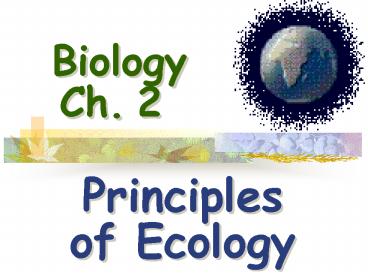Biology Ch. 2 - PowerPoint PPT Presentation
1 / 52
Title: Biology Ch. 2
1
Biology Ch. 2
- Principles of Ecology
2
I. Organisms and Their Environment
- A. Ecology
- - the study of interactions of living organisms
with one another and their physical environment
3
B. Biosphere
- - the part of Earth that supports life
4
1. Abiotic (nonliving) Factors
- - light, temperature, water, soil, climate, air,
fire, etc. - - determines what lives where
5
- Climatic Zones
- a) Polar
- - long, cold winter
- - very short, intense summer
- b) Temperate
- - 4 definite seasons
- - long growing season
- c) Tropical
- - no winter
6
Effects of Elevation on Temperature
Low (Altitude) High
Equatorial (Latitude) Polar
7
Olympic/Cascade Rain Shadow
Average AnnualPrecipitation (cm)
Altitude (m)
150
5000
4000
100
3000
2000
50
1000
0
0
West
East
8
Earths Curvature, Tilt Make Seasons
Winter Short daysLong nights
Summer Long daysShort nights
9
Air Currents and Climatic Regions
- Saharan Arabian deserts are _at_ 30 N
Congo rain forest is _at_ 0
South African Desertis _at_ 30 S
10
2. Biotic (living) Factors
- - producers, consumers, and decomposers
Secondary Consumer
Primary Consumer
Tertiary Consumer
Producer
Decomposers
11
C. Levels of Organization in Ecology
Earthssurface
Biosphere
Air
Soil
Snake
Bushes
Ecosystem
Pronghorns
Water
Hawk
Grass
Hawk
Community
Pronghorns
Snake
Population
Herd of Pronghorns
12
1. Population
- - a group of individuals of a species that
interbreed and living in the same area
2. Community
- all populations interacting in an area (biota)
13
3. Ecosystem
- - a community of living organisms and their
physical environment - - no definite boundaries
14
D. Organisms in Ecosystems
- 1. Habitat
- - a place where an organism lives
- 2. Niche
- - the role and position an organism has in its
ecosystem - - Specialization to niches reduces competition
15
3. Symbiosis
- - intimate relationships between organisms of two
species in which at least one benefits
16
a) Mutualism
- - relationship where both species benefit
Boxer crab with anemones in claws
17
b) Commensalism
- - relationship in which one species benefits
and one is not affected
Clownfish in host Sea anemone
18
c) Parasitism
- - relationship in which one species benefits
and one is harmed
Parasitic Isopod on fish
19
Which type of Symbiosis is this?Northern
Groundconeabsorbing food Salal roots.
20
Moss growing on Bigleaf Maple.
21
Lichens
22
Salt-Marsh Dodder drawing sap from pickleweed.
23
Mycorrhizae
24
Mycorrhizae
Maple without Mycorrhizae
Maple with Mycorrhizae
25
II. Energy and Nutrients
- - The Web of Life
- - Energy flows Nutrients cycle
26
A. The Flow of Energy
- 1. Sun
- - only .1 used by living things
- 2. Producers (autotrophs)
- - plants algae that make food
- - photosynthetic
27
3. Primary Consumers
- - herbivores (heterotrophs)
- - eat producers
- - retain 10 of energy
- Ex. (grasshopper, mouse, moose)
28
4. Secondary (and Tertiary) Consumers
4. Secondary (and Tertiary) Consumers
- carnivores spiders, hawk - retain 10 of
energy
29
5. Decomposers
- return nutrients in wastes and remains to
soil - bacteria and fungi
30
Energy Flow Loss
Heat
SecondaryConsumer
Producer
PrimaryConsumer
Heat
DetritusFeeders
Food Energy
Heat
31
Energy Pyramid The 10 Law
32
B. Ecological Pyramids
- - the amount of energy, number of organisms, and
biomass at each trophic (feeding) level decreases
as you go up the food chain
33
C. Biomagnification
- - water insoluble toxins and metals (DDT,
mercury, etc.) accumulate up food chain - - the most in animals high on the food chain
(eagles, falcons, orcas, pelicans)
34
Biomagnification
35
D. Nutrient (Biogeochemical) Cycles
- - organisms require essential nutrients for
growth (CHNOPS) - - nutrients are continually recycled within an
ecosystem
36
1. Water Cycle
Precipitation
- Evaporation
37
Hydrologic Cycle
38
2. Carbon-Oxygen Cycles
39
Carbon Cycle
40
(No Transcript)
41
3. Nitrogen Cycle
78 of Atmosphere
- Free Nitrogen
NitrogenFixation
Denitrification
Producers
Soil
Consumers
Decomposers
42
Nitrogen Cycle
43
Food Web
- Simple food web on a short-grass prairie
- Numbers represent trophic levels
44
Energy Flow andNutrient Cycles
Nutrients Cycles
Energy From Sun
Energy Flows
- Heat Lost at Each Energy Transfer
45
Land Food Chain
46
Aquatic Food Chain
Secondary Consumer
Primary Consumer
Producers
Tertiary Consumer
47
The
End
48
Primary Productivity Photosynthesis
O2 releasedto air
- Life uses lt .03 of the sun's incident energy
- Most is lost as heat from respiration
Energyfromsunlight
CO2 absorbedfrom air
Sugarsynthesized
Growth
Photosynthesis
H2O absorbedfrom soil
Mineralsabsorbedfrom soil
49
(No Transcript)
50
Water Cycle
Water vaporin atmosphere
Water vaporin atmosphere
Evaporationfrom land transpirationfrom plants
Evaporationfrom ocean
Precipitationover ocean
Precipitationover land
Reservoirs
Processes/Locations
Water inocean(reservoir)
Water inocean(reservoir)
Water inocean(reservoir)
Surfacerunoff
Groundwaterseepage
51
The Carbon Cycle
CO2 inatmosphere(reservoir)
CO2 inatmosphere(reservoir)
CO2 inatmosphere(reservoir)
CO2 inatmosphere(reservoir)
CO2 inatmosphere(reservoir)
CO2 inatmosphere(reservoir)
CO2 inatmosphere(reservoir)
Reservoirs
Processes/Locations
Burning offossil fuels
Fire
Respitation
TrophicLevels/Organisms
Consumers
Producers
Consumers
Wastes,Dead bodies
Wastes,Dead bodies
Wastes,Dead bodies
Soil bacteria detritus feeders
Soil bacteria detritus feeders
Soil bacteria detritus feeders
52
The Nitrogen Cycle
Nitrogen inAtmosphereReservoir
Nitrogen inAtmosphereReservoir
Electrical stormsproduce nitrate
Nitrogen inAtmosphereReservoir
Reservoirs
Processes/Locations
Consumers
Producers
TrophicLevels/Organisms
Wastes,Dead bodies
Uptakebyplants
Dentitrifyingbacteria
Nitrogen-fixingbacteria inlegume rootsand soil
Soil bacteria anddetritus feeders
Ammonia nitrate
Ammonia nitrate
Ammonia nitrate































